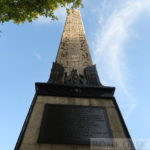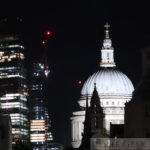- London is a port city on the river Thames and the capital of England and the United Kingdom.
- The Romans founded the city in c. 50 CE as Londinium, which became the capital of Britannia between 60–c.410 CE.
Roman History
- The first Roman Capital was at Colchester, but was moved to London after Boudicca's Revolt in 60/61 CE.
- The Governor of Britannia then resided in Londinium.
- The city was surrounded by a semi-circular 2 mile (3km) city wall. It was an important Port with extensive docks and warehouses, and the Thames was crossed by a wooden Bridge.
- Several Roman Roads radiated from London to the rest of Britannia.
- The Finds of Roman London are held in the Museum of London.
Museums
- British Museum
- Located at Great Russell Street, Bloomsbury, London, WC1.
- The Vindolanda Tablets are thousands of Wax Tablets each containing letters describing Roman Life on Hadrian's Wall.
- Various Roman Hoards are on Display such as the Hoxne Hoard and [yadawikilink=”Thetford Hoard”].
- Museum of London
- The Museum is now closed to visitors and will reopen in 2026 in a new location near Farringdon.
- Located at London Wall, Barbican, London EC2, it holds many artefacts from Roman London in a permanent display.
- Guildhall Art Gallery
- Located at Basinghall Street, London, EC2.
- The Museum contains the Remains of the entrance to the Roman Amphitheatre in the basement.
- UCL Petrie Museum of Egyptian Archaeology
- Located at Malet Place, London, WC1.
- UCL Petrie Museum of Egyptian Archeology
Roman Sites
- London Mithraeum (Temple of Mithras – Ruins)
- 12 Wallbrook, London EC4N 8AA.
- Over 14,000 items were excavated from the Site, some of which are on display in the Museum of London.
- Roman Wall, Tower Hill
- A section of the Roman City Wall is located in Tower Hill Garden next to Tower Hill Underground Station.
- Statue of Trajan, Tower Hill
- A copy of a 1st century CE Statue of Trajan is located in front of the Roman Wall, Tower Hill next to Tower Hill Underground Station in London.
- City Wall at Vine Street
- Opened in May 2023, this free Museum has a section of the Roman city wall on display, along with numerous Roman Artefacts which were excavated nearby.
- Roman Fort Walls (Ruins) Built 110 CE
- The Ruins are visible from Noble Street, London EC2V 7EE, south of the Museum of London.
- The Roman Fort Gate is visible from London Wall.
- Part of a Roman Building with a decorated floor.
- In the Crypt of St. Brides Church, Fleet Street, London EC4Y 8AU
- Entrance to the Roman Amphitheatre (Ruins)
- Guildhall Art Gallery
- Located in the basement of the Gallery at Basinghall Street, London, EC2.
- Watling Street Roman Road, London EC4M 9DD
- Although this street is named after Watling Street, the actual Watling Street Roman Road is the Edgeware Road, which crossed the Thames near Westminster and continued in a straight line up to St. Albans and Wroxeter. The Edgeware road still points to the river crossing at Westminster.
- Windsor Great Park
- Holds the remains of a Roman Temple from Leptis Magna.
- Clapham Roman Stone
- No 1 Clapham Common North Side, the ‘Omnibus Theatre’.
- In the front garden of the former Clapham Library Building stands an inscribed memorial block of limestone which was rediscovered in 1912, and is thought to be from the 1st century CE. It was originally found in 1777 in the Lanthorn Tower of the Tower of London.
- A very faded inscription reads ‘To the spirits of the departed and to Vitus Licinius Ascanius, he made this for himself in his own lifetime’.
Neoclassical Monuments
- Marble Arch
- This is based on the Arch of Constantine (315 CE) in Rome. It is made from white Carrara marble.
- Wellington Arch
- This was originally based on the Arch of Titus but then redesigned in a more splendid style, and is topped by a Quadriga.
- Nelson's Column
- Nelson’s Column is a stone monument and statue erected in 1843 in Trafalgar Square, London, England.
- It was built in the style of a Roman Victory Column with the statue of Nelson on top. It has a height of 169 feet 3 inches (51.59 m).
- Victoria Memorial, London
- Shaftesbury Memorial Fountain
- Erected in 1893, the Shaftesbury Memorial is a Neoclassical Monument located in Piccadilly Circus, London and is officially known as ‘Eros’.
- The bronze fountain is topped by an aluminium winged statue of Anteros, the Greek God of selfless Love, and not Eros (Cupid), the God of Love and Desire. The sculptor was Alfred Gilbert.
 Egyptian Obelisk
Egyptian Obelisk
- Cleopatra's Needle
- This is an Egyptian Obelisk located on the Embankment, near the Houses of Parliament.
Roman Shipwrecks
- Blackfriars Roman Shipwreck
- This vessel had sunk in situ still carrying its load of Kentish Ragstone.
- Some of its Remains are in the Museum of London.
- County Hall Roman Shipwreck
- This wreck had no cargo.
- Some of its timbers are also in the Museum of London.
London Bridge
- It is thought that Watling Street first crossed the Thames by using a ford at low tide at Westminster. It then continued up the Edgeware road, which still points at Westminster.
- In c. 50 CE, the Romans built a wooden bridge on piles across the Thames, which was probably burnt during Boudicca's Revolt in 60 CE.
- The bridge was then rebuilt, again using wood, allowing the roads south of the Thames, Watling Street and Stane Street, to connect with the roads north of the Thames.
- The wooden Roman bridge was located 100 feet (30m) to the east of the modern London Bridge.
 Roman Roads of London
Roman Roads of London
- Roads to the North:
- Ermine street
- to York
- Portway
- to Dorchester
- Watling Street
- to Wroxeter
- Pye Road
- to Colchester and Caistor St Edmund
- Ermine street
- Roads to the South:
- Antonine Itinerary:
Other London Attractions
- Top London Monuments
- St. Paul’s Cathedral
- Bank of England
- South Bank Centre
- Buckingham Palace
- Tower of London
- Tower Bridge
- Houses of Parliament and Big Ben
- Trafalgar Square and Nelson’s Column
- Top London Buildings with ‘Nicknames’
- The Walkie Talkie (or Sky Garden)
- The Shard
- The Gherkin
- The Cheesegrater
- The Onion or Armadillo
- The Mummy
- The Pringle
- The Scalpel
- Also:
- BT Tower
- 1 Canada Square
- The Heron Tower
- Tower 42 (formerly the NatWest Tower)
- St. George Wharf Tower
- Centrepoint
- Film Studio Tour, Leavesden
 Visiting London
Visiting London
- Major Annual Events in London
- London hosts a series of Events throughout the year.
- Major Annual Events in Britain
- This is a list of the major annual events around Britain.
- Public Holidays in the UK
- This list shows days in the year when Museums and Venues might be closed.
Tower Bridge


